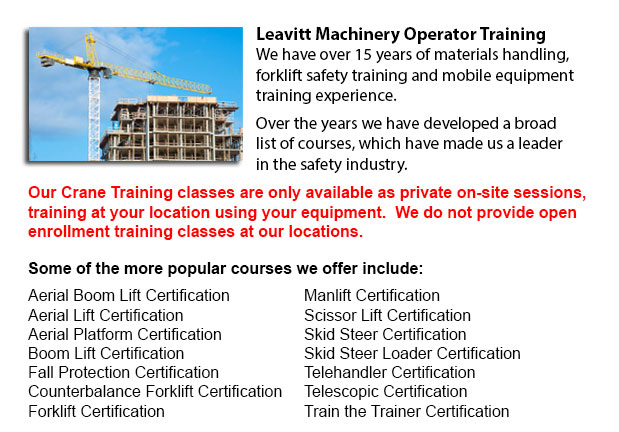
Crane Certification Burlington - The Crane Certification training program includes content recommended by industry regarding the efficient and safe operation of cranes. Trainees would learn the following: how to identify cranes and their component parts; pre-operational, operational and post-operating requirements; how to determine overall lift capacity; rigging components and inspection/rejection criteria; and requirements particular to the work place where the trainees will be operating.
The requirements which must be carried out prior to operating a crane includes assigning authority for the pre-operational check; doing the sequential pre-operational check based on the manufacturer's specifications or specifications certified by a professional engineer; checking the log book for comments; inspecting the work area for obstacles and hazards; checking cables, hooks, chains crane movement and safety latches; making sure of the correct functioning of operational controls; and learning how to ensure the disconnect switch/isolator of the crane is properly working.
Operational requirements comprise identifying responsibilities and roles, and determining the requirement for a formal lift plan. Individuals training will be taught how to carry out a hazard assessment associated to environmental situations, physical circumstances and workers. Subject matter comprises determining when to seek competent support, the destination of loads and the safest route, and load weight and centre of gravity.
It is essential for people training to be able to identify an over-capacity lift, select appropriate rigging equipment, know load limits, and determine a safe site from which to work. Trainees would review both universal and site-specific crane signals for lifts, and techniques for traveling, lifting and loading. Proper maintenance practice will be covered.
The person training will undergo an examination to test their understanding of emergency response procedures for different scenarios, specially mechanical or electrical failures. They would be asked to describe shut down and parking procedures for security and safety, to follow tagging and lock out procedures, and to explain why near misses are reported and recorded to the appropriate individual. Log book records need to be maintained.
Individuals training would develop knowledge of rigging, particularly, establishing who has responsibility and authority for rigging, identifying various kinds of rigging, knowing storage procedures and load capacity ratings.
Post-operational requirements comprise entering defects or deficiencies, maintenance and service history within the log book, based on provincial, federal and state codes requirements.
Site-specific needs could be incorporated into the safety training program according to the employer's needs.
-
Order Picker Training Burlington
Order Picker Training Burlington - Order picker's enables warehouse employees to lift pallets using forks. Also called a stock picker, this particular electrically-powered equipment is similar to a forklift except that an order picker is likewise uti... More -
Overhead Crane Training Burlington
Overhead Crane Training Burlington - The overhead crane is a piece of equipment which can lift and move huge, heavy objects which can't be handled by hands. Typically, overhead cranes are fixed in place. These equipment are capable of moving huge vol... More -
Aerial Lift / Boom Lift / Man Lift / Scissor Lift Training in Burlington
Lift tables or scissor lifts could elevate both people and goods vertically. They are normally used in construction, commercial and industrial environments. Commonly, the use of a scissor lift is to lift and lower supplies from one floor of a job loc... More -
Telehandler Operator Training Burlington
Telehandler Operator Training Burlington - Telescopic Handler forklifts or telehandler forklifts are usually found on construction places and their popularity continues to rise. The versatility of telehandler forklifts ensures that they are a valuabl... More -
Forklift Training Classes Burlington
Forklift Training Classes Burlington - Forklift are heavy pieces of industrial machines that are made use of in transporting and the handling of merchandise and materials. They are often known as Lift trucks and are found in all sorts of businesses.... More -
Boom Lift Training Burlington
Boom Lift Training Burlington - Aerial platforms or also known as elevated work platforms are devices that allow workers to perform tasks and duties at elevated heights that would not be otherwise accessible. There are a variety of aerial lifts avail... More -
Bucket Truck Training Burlington
Bucket Truck Training Burlington - The Vehicle-Mounted Aerial Work Platform or also called bucket truck training program is intended to decrease the risk of incident and personal injury while working in close proximity or with bucket trucks by effici... More -
Skid Steer Loader Training in Burlington
A skid-steer loader is an engine powered equipment that has a small and rigid frame. It is outfitted together with lift arms which are used to attach to different labor saving attachments and tools. Typically, skid-steer loaders are four-wheel drive... More

Forklift Training Burlington
TOLL FREE: 1-888-254-6157
Burlington, Ontario
forklifttrainingburlington.com
Email Us
About Us


